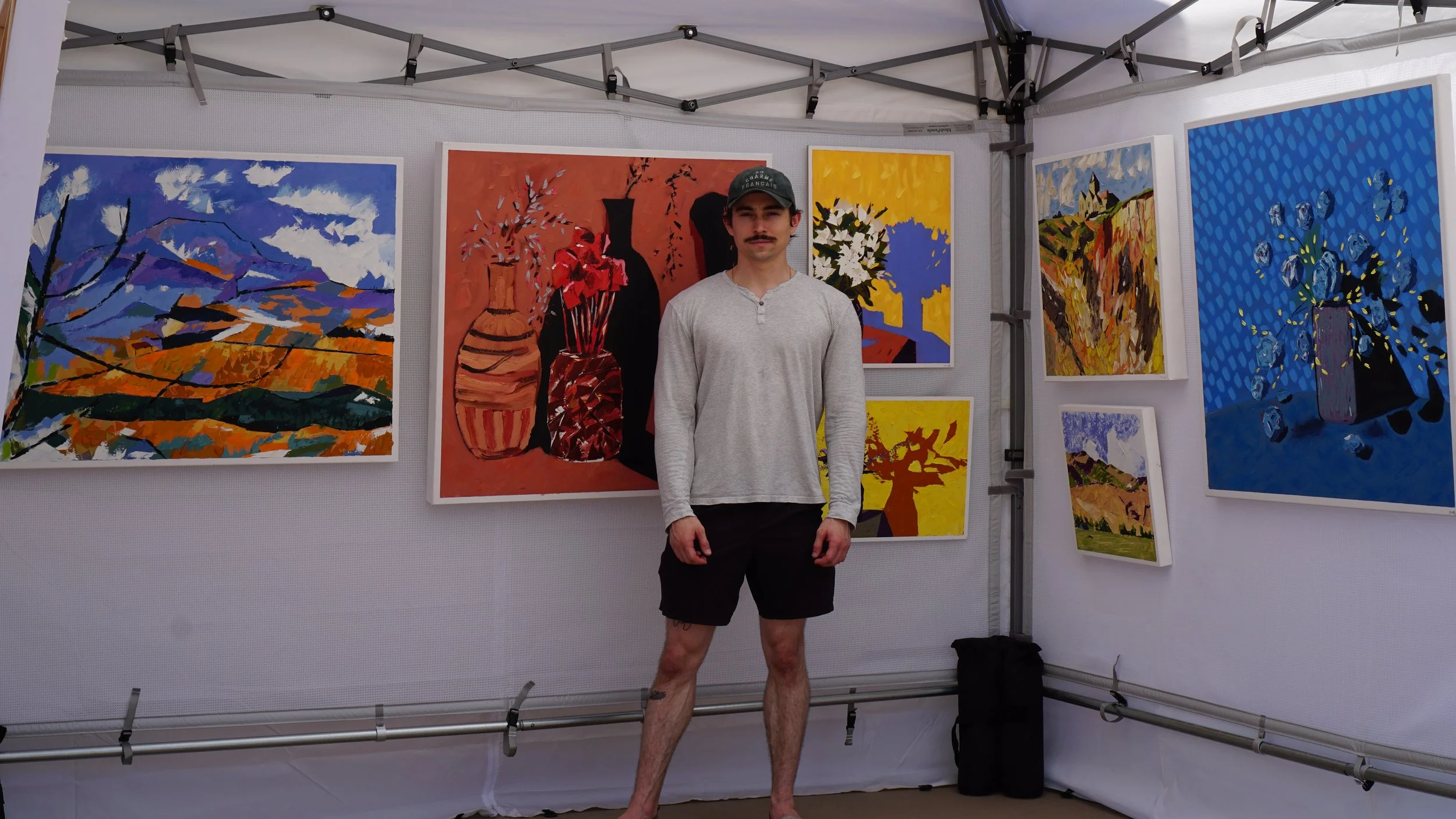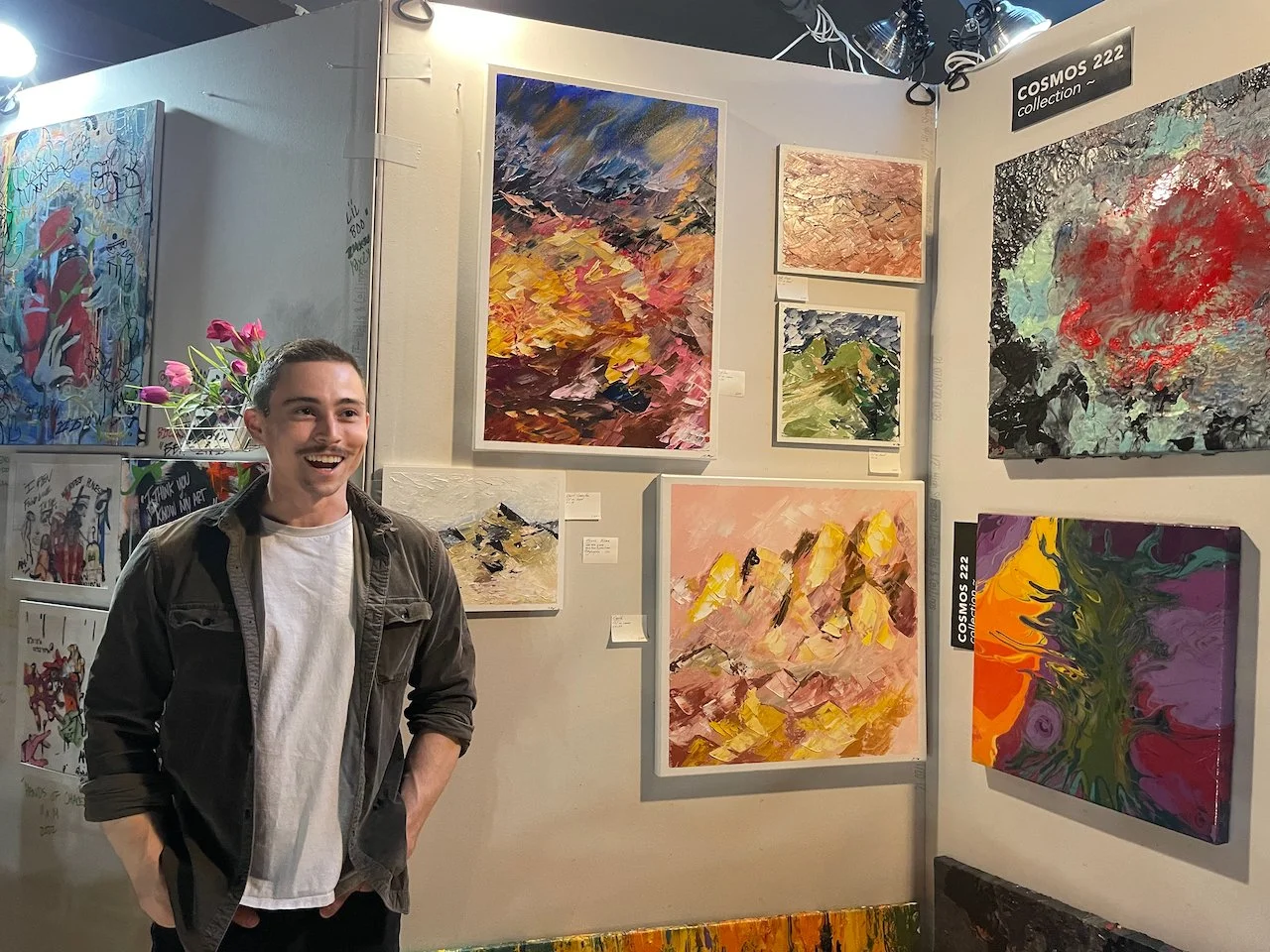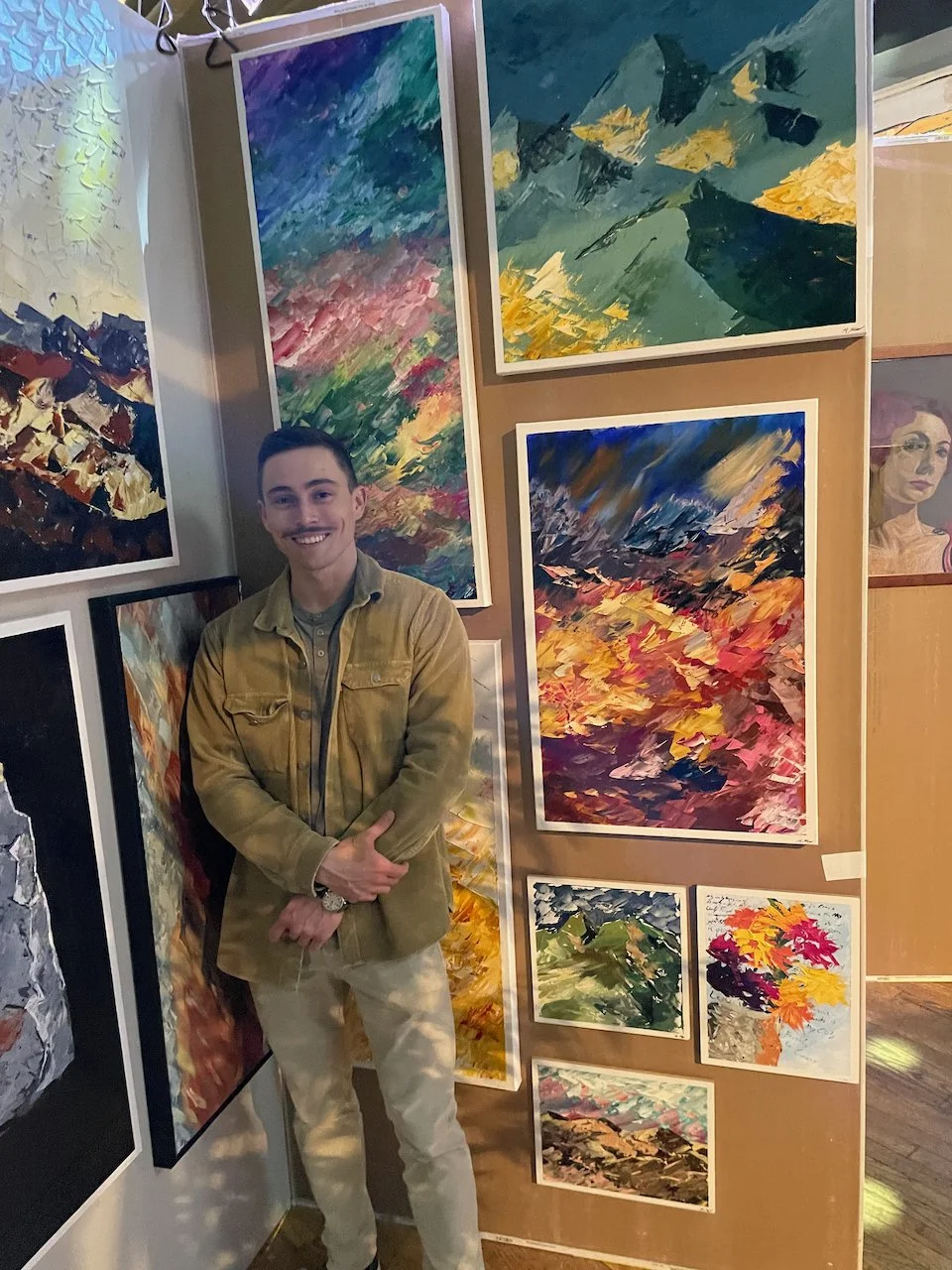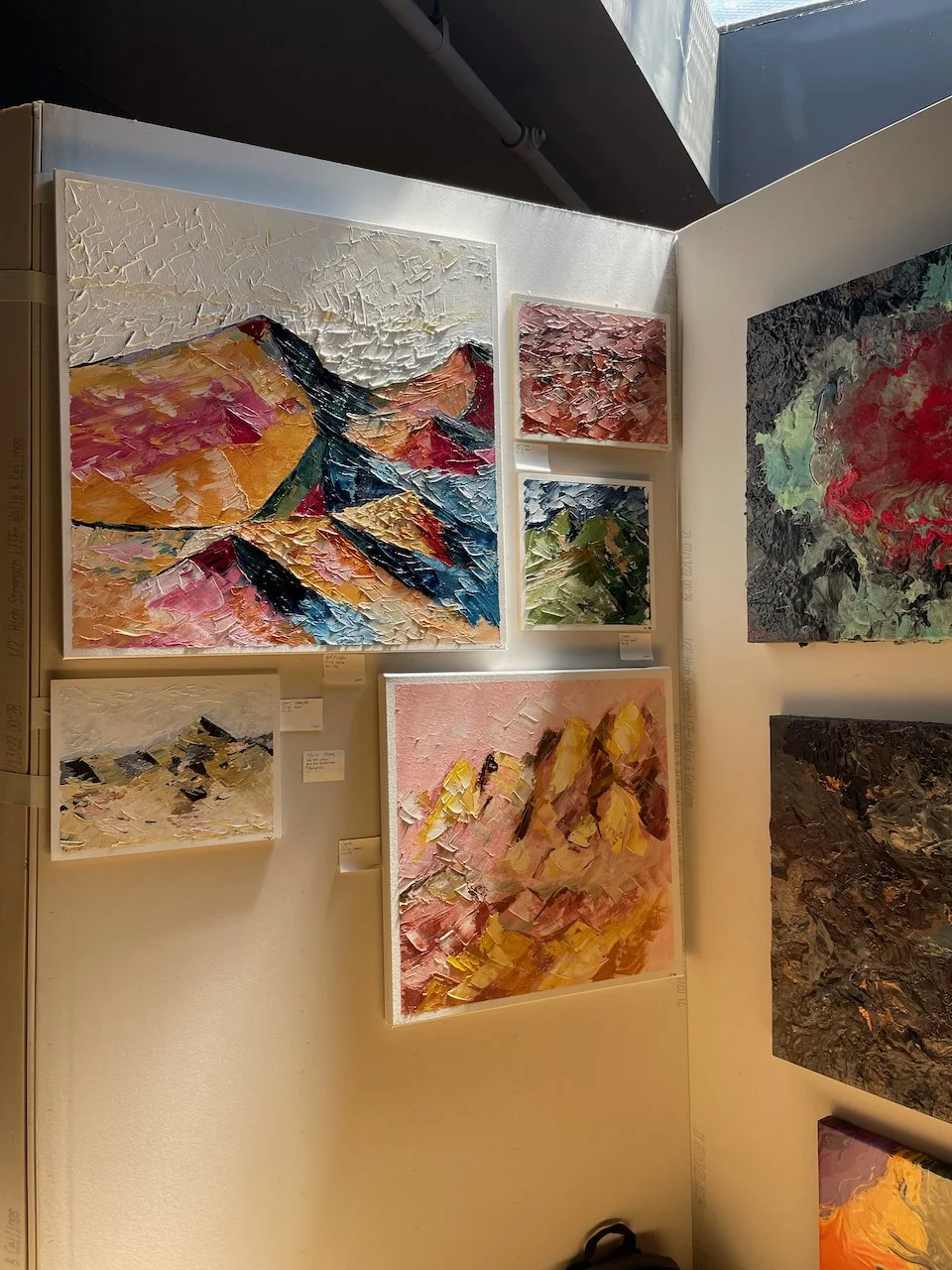Intelligently Gambling with Our Efforts—Why Go to Art Shows?
I reluctantly set up my booth for photographs on Friday. It was one of those days where I was running around all day—I spent the morning wiring canvases and the afternoon lugging paintings to and from Tempe in the Arizona summer heat.
I worked with my dad to get the tent up, using the new wall panels that I had ordered online to hang my wired canvases. I rearranged the S-hooks a few times to get the canvases at the right height and spacing. My dad was more opinionated than I expected—he’s spent years helping my mom and her friends with art shows of their own. He suggested I move some canvases up or down, or swap a painting here and there.
He was just saying how particular some artists are about their setup—I was being the opposite of particular. He was getting down into the details about which colors looked better next to each other. I appreciated his input, but I reminded him that this was just a demo, just an opportunity to take photos to showcase that I have a booth and that it meets all of the arcane requirements of the show.
I wanted to wrap it quickly. Part of my irritation stemmed from the fact that I needed these photos without knowing what I’m even aiming for—I’ve heard from my mom (a ceramicist) that this specific art fair requires that you have a white-canopied booth. Your booth must be weighted down. It must conform to all of these requirements, which, surprise, aren’t visible on their website. Better yet, the email contact never responded to my inquiries about recommendations for a new participating artist. Was there a checklist I could point to in order to ensure success for my new booth? No dice.
Thus, I had no idea to what end I was shooting the photos. Was I supposed to meet the few requirements I’ve learned via hearsay, discounting aesthetics? Is the shot judged on a checklist, or is it about the overall presentation, given that we can address gaps later? I made my booth look as pleasing as possible, because if you’re going to do something, you should do it right, then I took photos which illustrated all of the “checklist-y” items I could think of. My booth canopy is white, I have three walls which are wired directly to the frame, the tent is weighted, my walls are full of art. If I was setting up for the show itself, I know I would have spent more time getting everything to look perfect, but I wanted to get the photographs so that I could finish my application and close it out.
Not the photo I’m using in my application—”artist out of frame” as one of the few requirements they list for the photos.
Why Go to Art Shows?
My reluctance to set up on Friday stemmed from a greater skepticism of the effectiveness of participating in art shows to be a successful artist. I know very few getting-by or hobbyist artists who even claim that “going to art shows is worth it.” I can’t name one crushing-it-beyond-belief artist who swears by art shows.
Some might argue that it’s a stop-gap while you get your footing as an artist, accumulating clientele and presence. I would argue that it’s probably the most linear do-work-make-cash option available (and marketed) to artists. It’s certainly the most deterministic and easy to wrap our heads around—go schlepping art into a booth, sit and stand somewhere passively for two days, and only “act when called upon” by engaging with all customers who enter your booth.
Deterministic is good for the soul, but bad for massive success—I know the hardest part about being self-employed is the unease that comes from not knowing where you should put the most effort to leverage the highest result. It’s completely in contrast to being employed—you do work where told and get paid just the same.
I remember initially thinking it was odd that the higher up the software engineering ladder I went, it became less about how to build something, and more about what to build. It makes perfect sense: we increasingly compensate for taking on higher levels of risk and uncertainty—a low level engineer can be told where to spend his energy, and the more senior engineer is actively engaged in determining what will get the most bang-for-buck. Why spend six months working on a product if we don’t know it will translate to more happy customers? How can we brave the unknown and intelligently gamble with our efforts?
Thus I see the apparent parallel as an artist. Art shows have merit for the fact that they are a linear and mostly-accessible (save for opaque requirements) path to make a career as an artist. You don’t need to figure out the “what” and just need to solve the “how”—how do I get my paintings to this venue, how do I make an appealing booth, and how do I connect with clients to make a sale? All fairly easy steps that we can solve to answer a lack of income as an artist. Art shows also offer fun social benefits, which are the main reason that I’d be excited to participate. I like connecting with other artists. I find inspiration in what they’re making.
But from a business standpoint, can we do better than linear? Are the options not immediately obvious to us those which offer greater gains? Braving uncertainty for a long period of time is uncomfortable, but it offers the highest payoff, if we’re smart and make the right adjustments along the way.
The downside of traditional art shows is that they doesn’t provide any scalability. You might get more people recognizing your work year over year, but fundamentally you only have so many hours to sit in a booth. There aren’t multiple version of you that can make work and connect with clients at the same time. Prices are also “soft-capped” based on contextual offerings from your neighbors—you certainly could offer paintings at $30,000 if the artist next door has pieces under $1,000, but art fairs inherently promote the commodification of art to buyers. All these options, ready and available for you! Pick and choose!
The Demand Spectrum
I’ve been considering both arms of my business in these terms: I recognize where my demand is coming from, and I prioritize endeavors which contain some level of scalability. Most often, attempts “in the middle” represent the worst gains. I cite Taleb’s Antifragile for my thinking around the Barbell Strategy in which we expose ourselves to some amount of upside via risk, while protecting against catastrophic downside. Efforts “to be in the middle” don’t expose us to massive upside, but they do allow us to bankrupt ourselves if we misstep.
Thus, I have been assessing demand for my businesses on a spectrum, categorized by two factors: volume and qualification. I consider targeting or interest as a synonym for qualification. Qualification in a sales context considers that someone also has the means to pay for what you’re offering.
I see the spectrum as:
High volume, low qualification: Online/social media marketing
Middle volume, middle qualification: Art shows/fairs
Low volume, high qualification: Word of mouth/referrals, pointed discussions in-person with people who I know need my services—art on their walls, fitness goals to achieve, partnerships, door-to-door in targeted areas
Option 1: high volume, low qualification
So far, I’ve primarily leaned into the first option. The amount of people who can see your work via the internet is insane. Since I started using TikTok (last year) and Instagram (continued since 2018), I’ve accumulated 16k and 3.3k followers. The amount of people who see my work while I’m painting live, or those who see my talking-head video about my art or fitness clients, is mind-boggling. There’s an immediate question worth answering: “how engaged are these people?” The qualification is initially low.
However, I see that building a business online can serve as an inherent asset—I’m putting time into building an ecosystem, an “immersive world,” in which people can learn about fitness or art. The upside is that I’m able to reach an increasingly large amount of people, but the downside is that those people won’t initially engage with me, nor would they concern themselves with the value that I’m offering. They don’t inherently want to add art to their walls or enroll in personal training programs until they become familiar with why they should do so. I can make this value apparent to my supporters and circle over time.
What’s the downside, and what’s the upside?
When considering downside, I like to mentally check off the statement: “will I ruin myself if I participate? What if it becomes 95% of what I do?” The main downside that I consider with using the internet as a form of leverage is that everything I do is public. I’m attached to my ideas and I have skin in the game. If I do something dumb, I’ll suffer the consequences. However, outside of time spent producing videos and blog posts, I don’t have much potential for catastrophic-failure investment. If I spend 95% of my time executing on this path, the main downside is that my income might not catch up before the flywheel kicks in fully.
The upside here is that I’m increasing my surface area to encounter a “dream client” on the internet, one who aligns immensely with my artistic vision. I’m also chipping away at building a following, perhaps to the point where I never have to worry about who wants to purchase my next painting or enroll in my fitness packages. This is the reason that I’ve spent so much time on this first avenue: it offers scalability and security.
Building an identity online allows us to pivot into new endeavors and retain some of our momentum. I can spend time on assets like videos and blog posts which might allow someone to see my point of view, and hopefully they will connect with me in due time. Videos and media on the internet can work while I sleep. The flywheel takes some time to get going, but I have confidence in its value.
Option 2: middle-everything
As influenced by Taleb via the Barbell Strategy, I try to avoid staying in the middle. This is the land of the scraping-by, the race-to-the-bottom art shows. For the reasons outlined above, generally, pass.
Option 3: low volume, high qualification
I’m hoping to expand into this avenue as soon as possible. I’m considering the most high-touch, personalized, maximum-value offers which take significant effort on my part for a small handful of clients.
Commissions are the easiest way to understand this path. Typically a commission only comes from someone who is thoroughly interested in my art and invested in my growth as an artist. They also have a vision in mind that they need help executing—and this is where expanding skills as an artist or a designer helps us the most.
I’m planning on going door-to-door in areas with homes that I know have huge walls. (Targeted, I know.) I’ve done a bit of research to see if this is viable as an artist, and I’d rather just try it for myself and see. I consider that few people plan on buying a 5’x5’ painting online, as that might be a pain to ship and receive. However, I’d happily work to design a large piece for a landing with an open wall, expanding the service to include a precise match for the current home aesthetic, framing, and direct installation.
How does one shoot for “low volume,” anyway? Door-to-door might not actually be “low volume,” but it’s way less than exposure via the internet, and less than the traffic I’d receive at an art show. I think there’s significant merit in other highly targeted systems here; I’m hoping to partner with realtors, staging companies, or interior designers to give kickbacks for new homeowners who purchase or commission art for their empty walls.
What’s the downside, and what’s the upside?
The downside is simply the time spent on networking and lead prospecting. I’m not putting any major investment up front. I could envision particular clients taking up the majority of my time—often a commission will monopolize my painting production. When I work with someone to get the right painting to their space, then frame and install it, that’s taking up even more of my time—but that’s what I enjoy, anyway.
I see the upside as massive if I meet the right people or establish the right partnership. Unlike the “success by a thousand cuts” of an online presence, I consider that I might encounter someone who just moved into a home with empty walls, and they love my art, and they’re ready to employ my services to fill out their space. This is the sort of dream client that sounds like luck—but we have to consider that luck only works if you increase your surface area for opportunities. Getting out there via networking is the only way about it.
Why Am I Doing an Art Show, then?
I lugged all of the canvases back into my apartment and hung them on my walls by 5PM on Friday. I was fatigued, wondering what it’s all for—is this a worthwhile way to spend my time?
Despite my apprehension to set up for and apply to the show, I’m still planning on participating in these shows because they’re how I got my start as a professional artist, more or less. I had sold a few paintings by the time that I attended my first art show in San Francisco, but going to the shows solidified the idea that I could be a career artist. I met some great friends and made more sales than I expected.
In the greater trend of how I try to structure my life, I consider how things “fit the vision.” In the perfect world for myself, one in which I’ve achieved all of my goals, what would my day look like? I see myself painting, and I see myself connecting with art enthusiasts directly, helping them to improve the aesthetic of their homes and craft their perfect spaces.
I certainly see myself socializing over art. I see myself attending art shows for the vibes, picking up inspiration from other artists. I see myself networking with artists to continue to add to my network of partners, hoping to help distribute their work through my clientele. I can see that my attendance in these shows slots right into that vision.
However, I choose to prioritize the other two ends of the barbell as much as possible—it’s not a lot of effort for me to set up for a few shows here and there, and I can devote most of my time to a select few clients who support me while I cast a wide net on the internet to connect with more patrons and others who need my services.
How does this apply to my fitness business?
All of these concepts above have direct parallels to the second arm of my self-employment, personal training. I consider that using the internet enables me to cast a wide net towards helping people with their fitness goals—I’ve found that in my discussions with prospective clients, not everyone who comes to my pages is right for training. They might follow me because they align with my fitness content, but there’s no need for them to take advantage of my services—they’re already crushing it in the gym, and why mess with a good thing? I’d rather focus on helping people who need the help with their motivations and consistency, getting from “almost started” to “consistent crusher” and then expanding their practice to hit every one of their goals.
I’ve been using the internet to get my free resources out there for upcoming fitness enthusiasts; people who come to my page often leave a conversation with me with my free resources for weight lifting. So far, I’ve received over a hundred downloads on my fitness PDF—these aren’t necessarily “clients” in that I’m not requesting payment, but we’re still having an exchange that I think builds momentum in the online sphere. I learn if my product is helpful, they get distilled fitness expertise. Win-win.
I consider the middle-volume, middle-qualified to be analogous to working in a gym. I don’t have the aim to trade my time for money and exposure to clients by working in a gym. There’s only so much upside in working the floor at a gym, and I’d rather have the direct means to communicate and distribute my services.
Doing so online via my fitness packages with a select few clients has been the “low volume, high qualification” avenue thus far. I’m brainstorming how to narrow some services into a smaller niche, and I’m building out a program specifically around body awareness as a way to enhance our fitness adherence. I think there are benefits for artists as well—I’m hoping to offer an even more narrow “fitness for artists” or “art for fitness” program, which contains the overlap that I’ve found to bring success in both my artistic and fitness practices. Much of this stems from building and identifying physical momentum to create more, lift more, and simply stay in flow for longer.
I think this only would appeal to a handful of people, but I know the benefits are immense, spanning domains into all of the other practices in our lives which require long-term thinking and intense presence and mindfulness. The outcomes of these practices bring tranquility to our minds and enhance our emotional regulation, and I know that we can all benefit from the privilege of creation, whether that’s bodybuilding or painting.
Thanks for reading!



